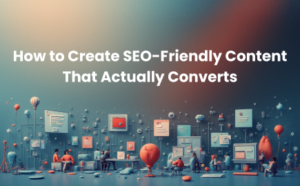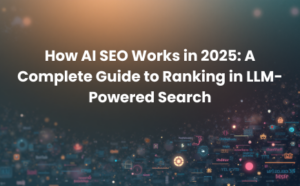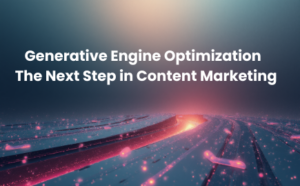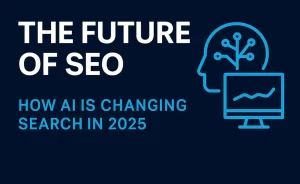SEO is evolving faster than ever. In 2025, artificial intelligence (AI), large language models (LLMs), and generative search technologies are rewriting the rules of how people find information online. Traditional ranking factors like backlinks and keyword density are being replaced with AI SEO trends 2025—where visibility depends on context, authority, and how well your content is understood by machines.
If your digital marketing agency wants to stay ahead, you need to master SEO, AEO (Answer Engine Optimization), and GEO (Generative Engine Optimization) — the three pillars of success in the age of Generative Search Experience.
Table of Contents
- From Traditional SEO to AI-Driven Search
- Key AI SEO Trends in 2025
- Why Search Generative Experience (SGE) & AI Overviews Matter
- Optimizing for Generative Search Engines (AEO + GEO Strategies)
- Natural Language, NLP & Conversational Queries
- Building Trust with E-E-A-T for Content
- Voice Search, Visual & Multimodal Optimization
- Tracking AI Visibility: New Metrics That Matter
- Ethical Challenges in AI-Driven SEO
- The Road Ahead for AI & Search
1. From Traditional SEO to AI-Driven Search
Old-school SEO relied on matching keywords, adding backlinks, and optimizing tags. But AI search engines now go beyond text—they analyze meaning, relevance, and intent.
In 2025, Search Generative Experience (SGE) by Google, Bing Copilot, and AI assistants like ChatGPT or Perplexity are shaping how users discover content. These AI systems don’t just show a list of links; they generate answers from credible, semantically structured sources.
That’s where Generative Engine Optimization (GEO) comes in—creating content that AI can easily interpret, summarize, and cite. The new rule: optimize not just for Google, but for AI agents.
2. Key AI SEO Trends in 2025
Here are the biggest AI SEO trends 2025 that are transforming digital visibility:
|
Trend |
What It Means |
Why It Matters |
|
AI Overviews / SGE |
Google and Bing now provide summarized results (AI Overviews) instead of just listings. |
These zero-click summaries display key info at the top of SERPs, so your content must be clear and authoritative to be included. |
|
Generative Engine Optimization (GEO) |
Optimizing for AI systems that synthesize answers. |
Being “AI-visible” ensures your content appears in AI summaries and assistant responses. |
|
Answer Engine Optimization (AEO) |
Creating Q&A-friendly content for voice and chat-based engines. |
Increases chances of your brand being the direct answer users see or hear. |
|
Zero-Click Searches |
Users get answers instantly on SERPs or AI assistants without visiting websites. |
Focus shifts from clicks to AI visibility and brand mention. |
|
Long-Tail Conversational Keywords |
Voice and chat queries like “What’s the best AI SEO strategy in 2025?” dominate search. |
Helps your content rank in natural, spoken, and question-based formats. |
|
Multimodal Search |
Searches using voice, images, and video input. |
Optimizing visuals, videos, and transcriptions boosts reach across platforms. |
|
E-E-A-T for Content |
Google and AI systems evaluate Expertise, Experience, Authority, and Trust. |
Essential for credibility in AI Overviews and SERP-less discovery. |
3. Why Search Generative Experience (SGE) & AI Overviews Matter
The Generative Search Experience is redefining how people interact with search. Instead of scrolling through pages, users now get summarized answers powered by AI Overviews.
For businesses, this means fewer clicks—but more visibility if optimized well. Appearing in AI summaries is like ranking at “Position Zero.”
To achieve this, your content must:
- Provide direct, factual answers
- Use structured data & schema markup
- Maintain trust and authority (E-E-A-T)
- Be easy for AI agents to read and extract information from
This is not about tricking algorithms—it’s about making your content machine-understandable while remaining human-friendly.
4. Optimizing for Generative Search Engines (AEO + GEO Strategies)
A. Structure Content for AI Readability
- Use clear H2/H3 headings with target queries.
- Add concise summaries after each heading.
- Include bullet lists, tables, and short paragraphs.
- Implement FAQ schema for Answer Engine Optimization (AEO).
B. Optimize for Generative Search Experience
To succeed in Search Generative Experience (SGE):
- Include original insights and trusted sources.
- Format text for AI scanning (short, factual, and structured).
- Track when your brand is cited in AI summaries — part of AI visibility tracking.
C. Leverage GEO Techniques
For Generative Engine Optimization (GEO):
- Write content that’s “citation-worthy.”
- Link to credible sources to increase AI trust.
- Use structured data and semantic markup to help models interpret meaning.
D. Align With User Intent
- Address informational, transactional, and navigational intents clearly.
Use long-tail conversational keywords like “How will AI change SEO in 2025?” or “Best GEO practices for digital agencies.”
5. Natural Language, NLP & Conversational Queries
Thanks to NLP (Natural Language Processing), search engines now understand natural language queries better than ever.
People don’t search for “AI SEO trends 2025”; they ask “What are the latest AI SEO trends for 2025?”
To optimize:
- Use semantic keywords and related entities.
- Write in a conversational tone.
- Add FAQs to address common questions.
- Optimize for voice search and chatbots by using everyday language.
Example:
Instead of “AI SEO 2025 strategies,” use:
👉 “How can I improve my SEO with AI in 2025?”
This makes your content relevant to voice search optimization and answer engines simultaneously.
6. Building Trust with E-E-A-T for Content
Search engines and AI models prioritize content that’s credible and transparent.
E-E-A-T—Expertise, Experience, Authority, and Trustworthiness—isn’t optional anymore.
To strengthen E-E-A-T:
- Include author bios and credentials.
- Add real-life examples, testimonials, and case studies.
- Link to reputable sources and cite data.
- Maintain updated, fact-checked information.
E-E-A-T is now a ranking factor not just for Google, but for AI-generated summaries as well. Reliable content is more likely to appear in AI Overviews and SERP-less discovery results.
7. Voice Search, Visual & Multimodal Optimization
The future of search is multimodal — blending text, images, voice, and video.
To win visibility in this environment:
- Optimize videos with transcripts and captions.
- Use alt text and metadata for all visuals.
- Ensure voice-friendly formatting—clear structure, natural language, and question-based headings.
- Implement VideoObject schema and ImageObject schema to help AI interpret multimedia.
Multimodal search ensures your brand is discoverable through all formats — from smart speakers to visual search engines like Google Lens.
8. Tracking AI Visibility: New Metrics That Matter
Traditional SEO metrics like rankings and CTR still matter—but they’re no longer enough.
New success indicators for AI-driven search include:
|
Traditional Metrics |
New AI Metrics |
|
Organic Traffic |
AI Visibility: Mentions in AI Overviews / SGE |
|
CTR |
Brand Citations in AI-generated summaries |
|
Keyword Rankings |
Question-based & Conversational Query Rankings |
|
Backlinks |
AI Citations, Schema Validation, Source Credibility |
|
Bounce Rate |
Dwell Time, Interaction, Scroll Depth |
Your ultimate goal isn’t just traffic—it’s visibility in the generative ecosystem.
9. Ethical Challenges in AI-Driven SEO
While optimizing for AI, brands must ensure ethics and transparency.
Challenges include:
- Misinformation from generative tools
- Over-optimization leading to AI spam penalties
- Plagiarism risks with auto-generated content
- Lack of transparency in AI-generated writing
Best practices:
✅ Always fact-check AI-assisted content
✅ Clearly disclose if AI tools contributed
✅ Avoid manipulative SEO tactics
Ethical optimization strengthens both E-E-A-T and long-term brand reputation.
10. The Road Ahead for AI & Search
By 2026, AI Overviews could power over half of all searches.
We’ll see:
- AI assistants delivering spoken and visual search results
- Cross-platform visibility across Google SGE, Perplexity, Gemini, and ChatGPT Search
- Personalized, predictive recommendations based on user behavior
- Integration of AR/VR search experiences
To stay relevant, digital marketers must evolve beyond traditional SEO and focus on AI visibility, structured content, and multi-platform optimization.
The future of SEO is not about ranking higher—it’s about being understood, cited, and trusted by AI.





